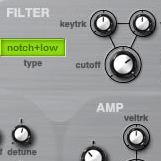
reFX Vanguard tips & tricks
May 29th 2012
Our resident synth whizz Gary F.L gives us some advice on programming reFX’s popular Vanguard synth. With these tip and tricks you’ll be making phat banks & patches in no time!
Sound design is a very competitive, tricky and time consuming process, new trends appear, and die very quickly. Good wholesome sound design requires innovation, a great amount of patience and sometimes a good nights sleep! If you stick to the simple yet effective fundamental theoretical approaches and techniques listed here, then in no time you’ll be the elite Vanguard sound designer you always dreamed to be. Yep, you too can achieve the sound of that French guy with the long hair…
Think of artists such as Spor, Noisia or Dirtyphonics. These people use conventional waveform selection, usually saw and square, but go crazy on everything else. Curiosity gets you places. So let’s throw the rulebook out of the window.
Try literally randomising your settings to start with: slam together different oscillator wave forms, envelopes & fllter settings. For example go crazy on waveform selection sometimes, mix and match. What you thought was a no go, is usually a ‘$%@k me that’s a crazy!’ sound. Your next step will be to refine your raw sound into something more usable and more importantly controllable.

Messing around with the LFO is great it adds depth to your sound, try to add LFO into your sounds and keep the speed low to give a fattening washy effect. Nearly every sound in ‘Oxygene’ by Jean Michelle Jarre (one of my synth programming heros) uses LFO.

Don’t use too much release in a dance lead, sometimes just a little will do, try using hardly any attack, a mid amount of sustain, and a mid amount of decay.

The detune control is a killer and can be the key to any anthem based dance sound. Try taking a sound with no detune and turning the detune knob to around 54% and compare the results.
![]()
You often don’t need 16 or 32 voices, sometimes just 5 can be enough, you’ll find turning the voices down can give your mix a more minimalistic sound. This Approach can also relieve essential CPU resources too if your running low!
![]()
The Vanguard’s filter can be extremely versatile: for plucky sounds try a low 24 decibal. For bass try low 12 db. For acid sounds try band+shp, notch and format. Being careful in this department can really help determine how your sound sits in the mix, so take your time and experiment.

The Vanguard’s trancegate effect can give some really cool effects – for more subtle fx don’t have it on max, keep the contour control knob low and the gate to around 60%. You can also get some crazy results by playing with the stereo and speed controls of the trancegate.

I’m not a big fan of the Delay unit on the Vanguard. It works better for me on background noises, so if your sound’s the centre piece I’d set the delay to ‘Widen’ with a short delay time to give your sound more stereo width.

The reverb unit on the Vanguard is great for electro. To get the ‘Benassi’ type reverb try this: adjust the mix to around 35%, pre-delay to around 40%, room size to around 15%, damp all the way up & width to 50%. This gives your sound that ‘sidechained’ feel. Glide can also be great on this kind of sound when you have overlapping notes in your sequencer.

So there we have it – a few points to consider when making your own Vanguard sounds – good luck! Check out our refx vanguard banks in our synth patch section.
Quick Links: Browse By Genre | WAV Sample Packs | MIDI Packs | REX Loops | Combi Packs | Reason Refills | Apple Loops